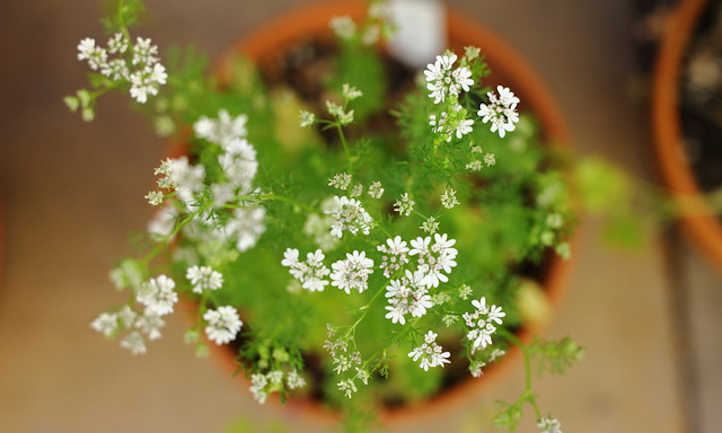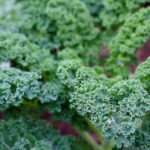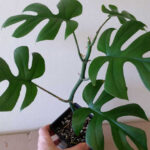If you are looking for easy-to-grow aromatic herbs that you can harvest in your garden year-round, cilantro (coriandrum sativum) is a great choice. With the right conditions, growing cilantro indoors rapidly supplies gardeners of both the indoor and outdoor variety an ample herb supply.
Although its origins are difficult to pinpoint, most botanists agree that cilantro hails from the Middle East to the Mediterranean. It is an annual herb that prefers well-drained soil. All parts of the plant are edible, including roots and seeds, and each has a distinct seasoning purpose. This is why it is used in so many culinary settings. Fresh cilantro added to a taco or salad is truly lovely!
Enjoy cilantro from your home garden at every stage of its lifecycle. Growing cilantro indoors offers many options including microgreens, fully grown leaves, all the way to flowered and seed-producing plants. It can be eaten fresh in salads or cooked into dishes.
Read through for tips to make your inside garden herb planting and harvesting worthwhile.
Ways Of Growing Cilantro Indoors
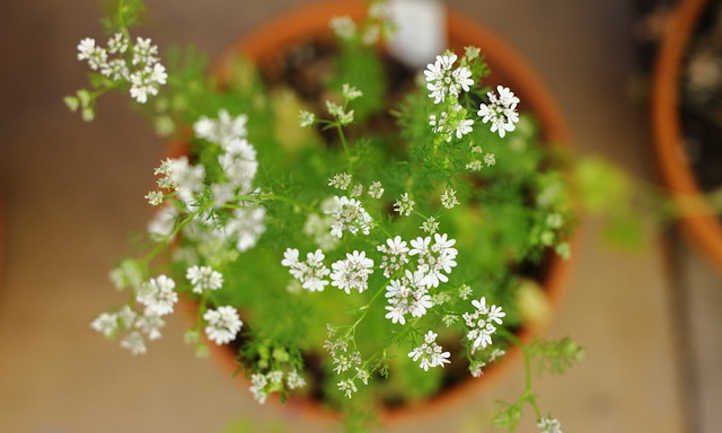
Let’s say you would like to grow cilantro, but you live in an apartment with little to no balcony space. Maybe mobility is an issue for you, or the climate in your locality gets too warm or too cold for cilantro. No problem at all! As long as conditions are right, it will do well indoors.
South-facing windows in the northern hemisphere provide cilantro with the ultraviolet light it needs to thrive. In the southern hemisphere, seek out a north-facing window. Here you can sprout your cilantro in a potting mix. Harvest microgreens before the root system develops, or you can allow the cilantro to grow fully. Both microgreens and mature leaves have uses in dishes, including salads and sandwiches. The flavor of both leaves and microgreens is very similar.
If a window is not an option, grow lights are an excellent alternative. Remember that purple LED grow lights will be an adequate light source, but they could make your plants prone to molds. This kind of light does not dry soil between waterings.
White and yellow grow lights are the closest simulation to actual full sun, which this plant prefers. An Agrobrite light is an excellent option for indoor growing as it provides light for a wide area. Because cilantro seeds are sown so close together, full coverage like this will do the trick. Grow cilantro indoors in trays wide enough to give the seedlings plenty of space, but small enough for your indoor growing area. Trays should have drainage holes, and be deep enough to support the cilantro root system. A depth of at least 8 inches is best for cilantro plants.
Watering will be paramount in your cilantro growing journey. Too little water, and cilantro bolts, making the flavor of leaves bitter and shortening the life cycle. Too much and cilantro may be in powdery mildew conditions. So choosing the best trays for your situation is very important. If you find that your growing medium tends to remain moist, use a misting bottle to water your cilantro. Alternatively, if the soil tends to dry out quickly, use a retaining tray to water from below.
The day-to-day moisture content of your potting soil will depend greatly on not only your soil media but the type and amount of light rays coming in. One way to help coriander seeds sprout is to provide a plastic cover that keeps moisture and warmth in creating ideal humidity. This could be a part of a set of trays with covers that you purchased, or it could be fashioned from items you have around your home. Once the seeds sprout, remove the plastic cover to allow plants to grow beyond their bounds.
Another fun method of cilantro growing can be done in a grow tent. Generally grow tents take up a bit more space than a window setup would, but if you find your counter space is more than adequate (a 2 foot by 4 foot wide situation) this might be the best option. Grow tents contain lights, and help cilantro plants retain the moisture and temperature needed to thrive.
Although harvesting hydroponically grown cilantro may not provide as much yield as other herbs, it can still be done. In this kind of setting the right temperature and pH conditions are necessary. Try a full setup to grow this herb in a hydroponic system.
Caring For Indoor Cilantro
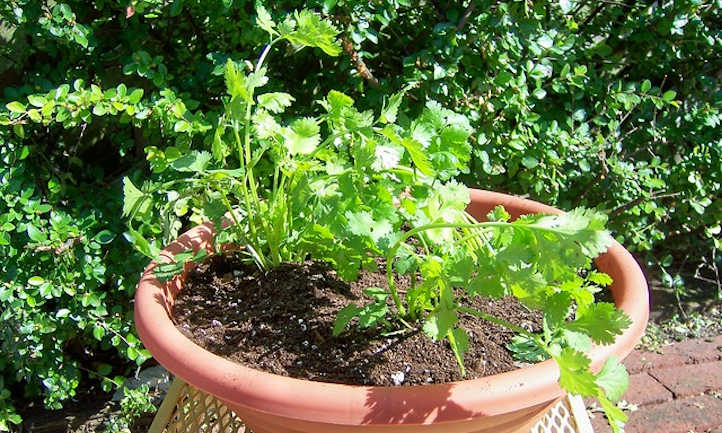
So how should indoor growers attend to cilantro plants in each of the settings listed above? Follow these steps and find out. You’ll have cilantro in your home year-round.
Lighting & Temperature
In general, cilantro (coriander) likes full sun to partial sun, which means at least six hours per day with a little bit of shade in the hard afternoon sun. In situations where the temperature rises above 75 degrees, cilantro is prone to bolting and flowering. This completely changes the flavor of cilantro leaves, making it more difficult to fit into a flavor profile. Monitor the temperature inside your house and around the growing area. In winter, you will likely have less of a problem with too much sun or heat as temperatures don’t rise above the preferred set. Plants can enjoy more hours per day of sunlight in colder seasons. In these times, a heating mat might be a good option, especially if the temperature is expected to dip well below the 75 degrees Fahrenheit optimal growing temperature.
With grow lights, it’s not necessary to find the best location, as you’re already creating optimal conditions. But if you want cilantro growing in a window, be sure you place your trays in a south-facing window in the northern hemisphere, and a north-facing window in the northern hemisphere. Planting cilantro in trays in either of these areas depending on the situation gives the full spectrum cilantro needs. If you are sprouting seeds with plastic covers, remember to remove the cover when the seedlings grow. They don’t like too much humidity. In a hydroponic setting, make sure temperatures do not exceed 80 degrees Fahrenheit. The same sunlight conditions apply.
Another great way to ensure cilantro gets the amount of sunlight it needs is to rotate trays daily. This gives cilantro sunlight on each leaf and prevents plants from reaching for sunlight which can cause nutrient deficiencies. Overall, rotating containers will give photosynthesis a boost and allow the plant to absorb necessary nutrients.
If sunlight isn’t copious enough for cilantro needs in your home, try an indoor growing setup. As mentioned above, there are a few different options that should work just fine for cilantro. Grow cilantro indoors under a grow light with a timer, or manually turn the source on and off for the most favorable leaf production. In a grow tent, the same technique applies. Find one with a timer if you know you won’t be able to be there to manually turn it on and off.
One final note about placement when you grow cilantro indoors: try not to keep your trays, container, or grow tent near an HVAC system vent. Too much heat dries out the soil and tells cilantro it’s time to start producing seeds to be sown for next year. Too much cool air will stunt plants when you grow cilantro indoors. Humidity is an important aspect of understanding how to grow cilantro indoors. Too cool and wet of a climate, and you’ll find that cilantro is prone to powdery mildew.
Water & Humidity
Since cilantro prefers consistently moist soil, start by watering seedlings with a spray bottle. In a setting with a lot of sun or more intense heat, check soil one to two times per day to ensure it is moist but not overly wet. If your potting mix tends to dry out often, try watering from below in a retaining tray. Monitor the water content in the retainer to assure there is adequate absorption. If you find the retaining tray is full of water too often, resume watering from above.
Typically cilantro seeds and seedlings need more water than an established cilantro plant. But make sure soil does not completely dry out. When soil is dry add water. In higher heat settings this will mean watering more frequently. In cooler settings, you’ll have to water less.
Grow tents will retain humidity more than open tray growing. As mentioned above, cilantro doesn’t need higher humidity after the seedling stage, and it prefers a drier climate. In grow tent settings, check leaves regularly for evidence of powdery mildew. The same goes for hydroponics where the growing medium (water) will offset and evaporate providing more humidity.
Growing Medium & Container

Cilantro prefers well-drained loamy soil. A good organic potting mix or potting soil will do the trick. You can grow cilantro in pots or large trays at least 8 inches deep. Your container can be a terra cotta pot or a plastic tray. Whatever is available to you will have the most bearing on the situation you choose. If there is not enough space for a wide tray, a pot will do just as well. Be sure containers have enough drainage. And pots or trays will both need something to catch water from below.
If soil is a less desirable option, there are other mediums like coir that can be used. Simply break up the medium and place it in a pot to sprout seeds. In this instance, watering will not have to occur as often as it would in soil. Growing in a non-soil medium indoors is easy as long as foundational conditions are met.
If you plant cilantro in a self-watering container, keep an eye on the moisture content of your growing medium. Self-watering containers make watering plants easier, but may be more disposed to mold than a terra cotta pot which wicks away moisture from the soil, or a growing tray that tends to retain moisture for plant absorption. For a hydroponic setting, try a full kit, and make sure the water used in the system is the correct pH (6.5-6.7).
Fertilizing
There’s a bit of debate over whether or not to fertilize cilantro. A good rule of thumb, though: avoid fertilizer at the seedling stage. Once plants are established they can take an infrequent water-soluble fertilizer. Wait at least four weeks after sprouts emerge to apply. If you don’t have fertilizer handy, no problem. As long as you have a rich growing medium, cilantro will do just fine without fertilizer.
Pruning
Once cilantro gets going, get clipping! Harvesting cilantro is a cinch. As most herbs do, cilantro growth increases with each cut. If you prefer cilantro microgreens, snip one-inch tall seedlings at least twelve hours after the last water. If you are cutting fully grown cilantro leaves, use kitchen shears to clip at the growth point. The more you harvest cilantro tips, the bushier it becomes.
Once cilantro flowers, the flavor of the rest of the plant changes permanently. You can still clip off flowers at this point to keep growth going, but don’t expect to use it in the same manner as you would before. Just like the rest of the plant, fresh cilantro flowers can be eaten raw or cooked. Harvesting cilantro before flowering is best, as the flavor is easiest to work with at this point.
The best option once the plant begins to flower is to let it bolt, and collect cilantro seeds for next season. You can collect green coriander seeds in a paper bag and in just a few days they’ll be dried and ready for storage. Another method of collecting coriander seed is to cut bolted stems and hang them upside down inside a bag. As stems dry, seeds will drop into the bag, and you won’t miss a single one.
Planting

Planting cilantro is best done from seeds. Cilantro seedlings tend to experience transplant shock. Each coriander seedpod contains 1 to 2 seeds, and seeds can be sown relatively close to one another at 2-3 inches apart. If you are growing in a container that’s about 12 inches wide, sow up to 12 seeds in one row. If you sow too many seeds, don’t worry. Overcrowding isn’t a huge issue for cilantro, especially if you have the opportunity to thin seedlings as they rise from the soil to 8-10 inches apart.
It’s not necessary to soak coriander seed to help growth, but doing so could assist in the germination process. To do this, break seeds up gently in a plastic bag with a rolling pin. Then soak them in enough water to cover them for 12-24 hours. Afterward, plant cilantro seeds just as you would dry seeds. Microgreens are ready within 2 weeks. Mature cilantro leaves are ready for harvest at four weeks. A coriander plant grows to maturity in 45 days.
For hydroponic setups, use the same seed-soak method detailed above. Then in three batches, spread cilantro seed in a colander over five to six days. As each batch starts, transfer them into your hydroponic system for harvesting.
Troubleshooting
Insect pests, hungry bunnies, and voracious deer are not a huge issue when growing cilantro in your home. But there are a few things to keep an eye on, most of which are related to light and water conditions.
Too much water and low light can lead to powdery mildew, a fungus that damages leaves at first, and then the entire plant overall. If you notice powdery mildew on your herbs, remove the damaged parts of your plant and allow the soil to dry some before adding water again.
When soil is too wet, it can also attract fungus gnats which will feed on the roots if left to grow. Adult gnats are easy to control with sticky traps and by reducing the amount of water you apply, but their larvae are a bit trickier as they’re hidden within the soil. Keep a watchful eye out to catch adults quickly so they don’t lay eggs that become those dreaded larvae!
Another situation that arises from too much water or poor drainage is root rot. In this case, the first sign shows when leaves wilt. To check for root rot, lift the root system out of your tray or container and examine the root color. If the roots are brown as opposed to white, it may be time to say goodbye to your plant for the season. If there are still white roots, try removing the rotten ones, and provide your cilantro plant with all new potting mix.
Coriander plants can also be prone to wilt if they are under-watered. To remedy this, maintain consistent watering, not too wet nor too dry. Moist but not soggy soil is ideal.

